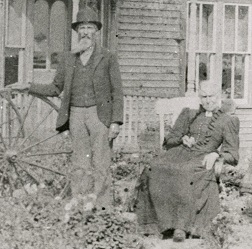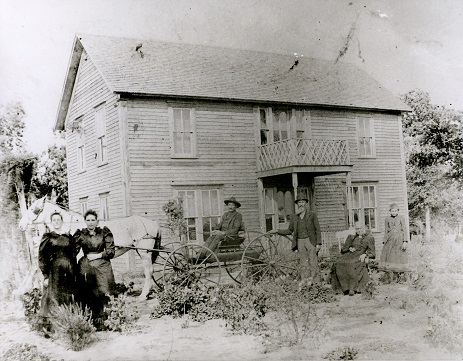
|
|
|
Photo
of the Month |
|
|
HOME AT LAST -- in February 1895, having left Elm Creek, Kansas seven years earlier, Oklahoma pioneers James R. and Lydia (Miner) Brown received a long-awaited Homestead Certificate No. 116 for what became their more or less permanent home. It consisted of this tract of 160 acres in Excelsior Township, Kingfisher County, located to the west of the Indian Meridian line. The certificate bore the signature of President Grover Cleveland, probably signed by one of his secretaries or deputies of the General Land Office.
 The land was endlessly flat. Winds blew constantly. The ground was covered in a sea of native prairie grass that had been in place for thousands of years and provided a natural feeding ground for wildlife. In his book
The Worst Hard Time, author Timothy Egan has written that in the spring in Oklahoma, "the carpet flowered amid the green, and as wind blew, it looked like music on the ground... the world's greatest grassland." Farmers bent on raising wheat and corn had to undertake to
cut up the thick sod which revealed a rich bed of red soil -- "red dirt." The work would have been back-breaking, even with a good horse and plow.
The land was endlessly flat. Winds blew constantly. The ground was covered in a sea of native prairie grass that had been in place for thousands of years and provided a natural feeding ground for wildlife. In his book
The Worst Hard Time, author Timothy Egan has written that in the spring in Oklahoma, "the carpet flowered amid the green, and as wind blew, it looked like music on the ground... the world's greatest grassland." Farmers bent on raising wheat and corn had to undertake to
cut up the thick sod which revealed a rich bed of red soil -- "red dirt." The work would have been back-breaking, even with a good horse and plow.
The Browns originally had come to Oklahoma in 1889 to an area known as the "Unassigned Lands," two million acres previously had been set aside as reservations for the Cherokee, Chickasaw, Choctaw, Creek and Seminole peoples. While the federal government had a grand but flawed plan to entice Indians into the benefits of land ownership -- theoretically to help them mix better into the white culture -- the Kingfisher section became available for non-Indians. In leaving Kansas, their "outfit consisted of two covered wagons which was trailed by a one horse buggy," wrote a grandson. The Browns' daughters Nellie and Laura rode to Kingfisher in a buggy drawn by a "mule who was gentle," said the 1976 book Pioneers of Kingfisher County. Many years later, their daughter Nellie wrote:
[James R. Brown] was a man about 55 years of age, well educated and refined, who had met with reverses in fortune and with his family was seeking a home in the new country. He had with him on this trip his son Frank, 23 years of age, and the daughters, Nellie, 21 and Laura, 16 (Mrs. E. A. Barnum). His wife and two younger children remained in Kansas with a married daughter.
The sisters arrived just south of where the Kingfisher Cemetery now is, about one mile west of the town. They lined up at the "jumping off point" alongside many other eager prospectors and families at the starting line at high noon on April 22, 1889. A gunshot sounded, the signal to cross the line and begin making claims. More>>>
|
|
|
VisitPITTSBURGH is the promotional sponsor of this page. Be sure to get your copy of the Greater Pittsburgh Convention & Visitors Bureau's Official Visitor's Guide |
|
Copyright © 2015 Mark A. Miner |
